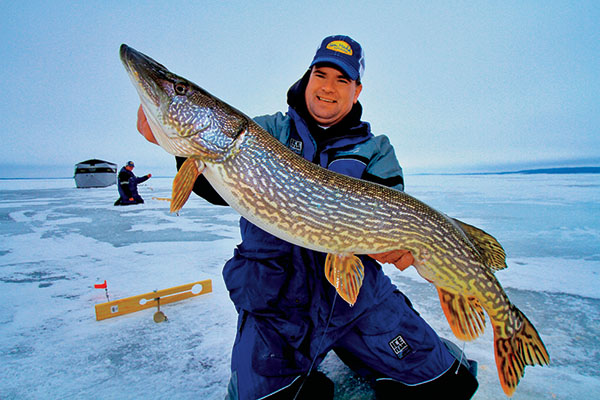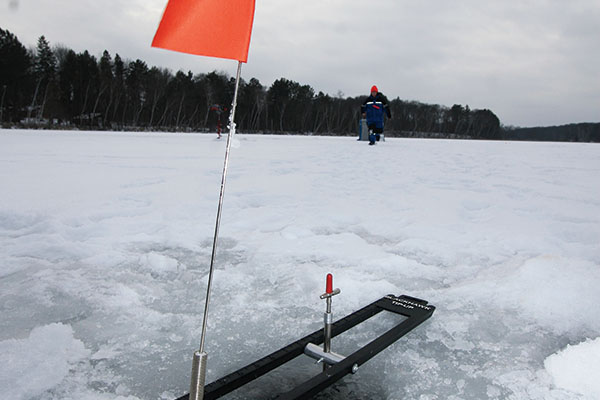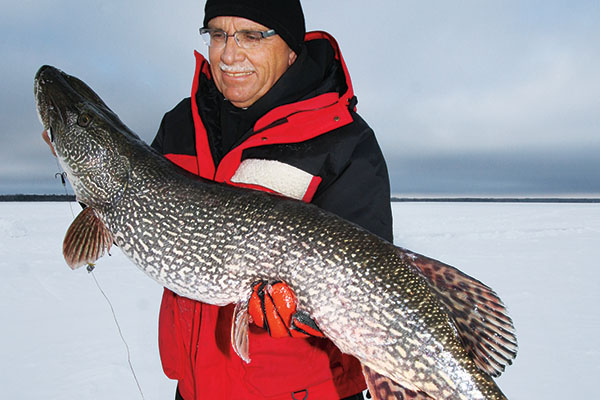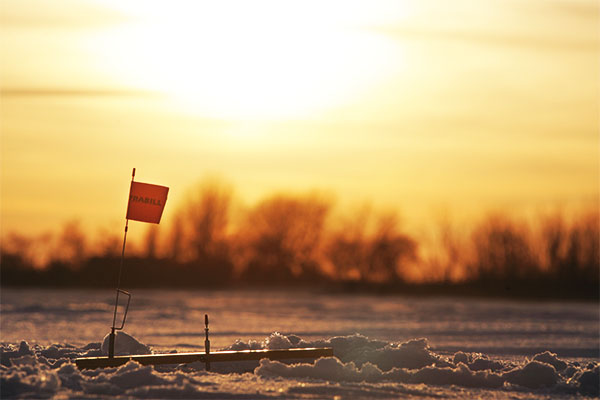

One of my best open-water catches of several seasons ago occurred unexpectedly on November 16. I planned to shoot an In-Fisherman TV show segment on basin crappies, but the night before was bitter cold and windless. When I got to the local lake that I wanted to fish, it, and all the smaller surrounding lakes, had 2 inches of ice.
The week before, I shot a show segment on a large nearby lake, so I knew that some walleyes and pike should still be using a large weedflat with a non-distinct edge in 12 feet of water. The edge runs for at least half a mile. Some fish would also still be scattered on the large flat. In three hours of fishing, the walleye count pushed past 25-but the area was also holding lots of nice pike. I cleaned two smaller pike and found them packed with 3- and 4-inch perch.
That large lake was Minnesota’s famous Mille Lacs, 130,000 acres, which often takes a long while to freeze. Exactly one month later, I eased my way out toward the waypoints I had entered into a handheld GPS that last day on open water. The cameraman followed with his equipment as I prodded the ice, checking thickness as I went with a spud bar. Finding a solid 4 inches, we were soon set up over one of the same areas that held so many fish earlier. No surprise, given that we were the first ones on the spot, the fish were still there-and we quickly finished a show segment outlining a first-ice system for fishing chubs with circle hooks below HT Polar Pop-up tip-ups. More on this later.
Rule one at first ice is try to identify great spots that are holding fish just before ice-up and get back on those fish as soon as you can do it safely once the ice goes on. The best spots typically are large enough to hold lots of baitfish, which of course is what keeps the pike in the area into first ice. Giant weedbeds are a classic. On smaller lakes the time frame between when you can no longer fish on open water and when you can get back out at first ice often is less than two weeks-and with the right conditions can be days.
Location
Failing to have the opportunity to find a great spot before freeze-up, we must rely on long-identified classic spots to fish at first ice. Again, main-lake and reservoir weedflats and edges, or the same types of areas in large bays, are well known hot spots. Pike also move into river side-channels and backwaters-again often spots with vegetation. Some pike also spend time hunting over rocky areas in natural lakes and reservoirs, especially spots in deeper water than vegetation would typically be found. Look for rocky points at the mouth of larger bays, with hard-bottom drop-offs into 20 or more feet of water. Or look for the rocky edges of larger sunken humps.
Saddle areas in conjunction with rocks or similar pivot areas in or near weedbeds are other top options. One memorable trip in my early ice-fishing career was the result of looking at a lake contour map of a remote portion of the Winnipeg River system in Manitoba. One obvious spot was in a giant bay-a rocky hump 50 yards long and 25 yards wide in 20 feet of water connected via a 25-foot deep saddle that ran for several hundred feet to a rocky shoreline point. Deeper water surrounded the hump and saddle.

We set deadbaits around the edges of the hump and at various spots on the saddle. The sweetest spot was where the saddle connected to the inside edge of the sunken island. We caught a dozen fish surpassing 20 pounds in two days of fishing, including two fish right at 25 pounds, the first impressive catch of giant pike for me, this in the early 1980s. That’s an unusual catch at first ice, though, which often is more of a numbers game on many fisheries, with big fish happening along from time to time. Late ice is a better option for giant fish-another story.
Specific patterns often emerge on individual waters. On Devils Lake, longtime guide and television personality Jason Mitchell has fished many patterns over the years. Mitchell: “I used to concentrate only on weeds, but rocks have been hot the last years. Many of the best spots are in the main lake. And they often have a combination of elements, usually including a shallow flat, some rock, often some vegetation, and a sharp break into deeper water. I concentrate on water less than about 15 feet deep most of the time.
“Flooded roadbeds are top options. The old gravel roads now have cabbage growing on top and rocks in the ditches alongside. Rocks with nearby flooded timber and brush can be good, too.
“A similar pattern often holds on Missouri River reservoirs. In low-water years, willows and cottonwoods grow along the shorelines wherever there’s sand, while rocky areas stay mostly devoid of trees. I first look for high banks near creek channels. In front of the high banks, big rocks often lie submerged and there’s quick access to deeper water. Next I look down the bank to where it begins to transition into a more gradual slope. This is where the brush and timber begin and that’s where some rocks meet sand and brush. Those sweet spots are pike havens. Another pattern is to look for rocky drop-offs at main-lake points or secondary points inside big bays.”
Mitchell reports that Oahe, Sakakawea, and Peck are loaded with nice pike right now: “Fort Peck has become one of my favorite destinations. It’s remote and has lots of pike in the 30- to 40-inch range, with a shot each time out at something approaching a top-end size of 45 or 46 inches. The fish are girthy, too, from feeding heavily on ciscoes. All the major bays have pike, but I’ve been fishing Dry Arm. I use frozen herring or smelt below tip-ups-six per angler. For more information check Missouri River Country, missouririver.visitmt.com.”

Rigging
We have written extensively about pike presentations, including articles in the Annual Ice Fishing Guide. Consult in-fisherman.com to review some of those writings. The fundamentals also are covered in our book Ice Fishing Secrets. Tip-up sets are the norm, although active jigging with lures like the Jigging Rap also produce lots of fish at first ice. Much is dependent on how many lines an angler is allowed. It’s always helpful when anglers can make multiple sets of more than two lines.
Factoring Fluorocarbon-I now have many seasons under my belt fishing with fluorocarbon as a leader below most of my tip-ups without ever being bitten off. I began fishing with 30-pound, quickly dropped to 25-pound, and switched five years ago to 20-pound. Fishing the 20-pound I’ve landed fish as large as 18 pounds and probably iced over 100 pike. I still use 27-pound Sevenstrand wire as leader when fishing for big fish at last ice. There’s still always a chance for being bitten off when using lighter fluorocarbon.
The relatively light 20-pound fluoro is particularly important at first ice, because livebait is the standard at this time, as opposed to deadbait sets which predominate during midwinter and at late ice. Rigged on a single hook, a medium-sized livebait is a great pike presentation, while still swimming actively. The 20-pound is significantly more supple than 25-pound.
Factoring Hooks-A single hook, as opposed to quick-strike rigging (tandem treble hooks), is best with livebait. I’ve also done extensive experimenting with hooks over the years. Most anglers fall into one of two camps-some use an octopus-style hook; others use a treble.
You can do better than the standard octopus by switching to a wide-gap hook like the original Kahle design by Eagle Claw, the Lazer Sharp L141, which has a straight-tie eye, or the L144, which has a snell eye. This design is a phenomenal performer. For baits of about 6 inches, when I’m fishing for pike and walleyes in the same area at the same time, I use a #6 hook. For bait as big as 8 inches, I switch to a #4. Insert the hook point just below the skin, with the point riding forward (toward the bait’s head), parallel to the dorsal fin.
The best performing treble I’ve found is the Lazer Sharp L774, which is a 4X strong hook-as opposed to the 2X strong hooks that most anglers use. The 4X hooks are much stiffer than 2X hooks. The heavier, stiffer wire does a better job of hooking up because the hook points don’t “roll” or bend at all on the hook-set. Again, I use a #6 hook for 6-inch baits and move up to a #4 for bigger baits. Insert the treble with one tine just under the skin at the dorsal fin.
Factoring Stealth & Release-I spend time fishing on Mille Lacs, because it’s near our office, and it has produced fine combination fishing for pike and walleyes at first ice most years. With the present catch-and-release regulation and prior strict slot limits on walleyes, I started to experiment with circle hooks because they usually hook fish in the mouth, allowing them to be released successfully.

Circles also figure neatly into a stealth system that produces good results at first ice, when thin, clear ice over shallow, clear water often results in spooked fish when anglers rush to the hole after a flag goes. With circles you can wait once the flag goes, taking your time getting to the hole, without having to worry so much about deep-hooking a fish. Your hooking percentage also increases when the fish aren’t directly below the hole when you set. The only time I rush to a hole is if a fish hits and runs, which is indicated by a wildly turning spool. Sometimes at first ice you get a lot of this, because many active fish are in the same area and small fish especially often try to move away from other fish once they grab their prize.
The hook that I’ve used successfully is one of my favorites on ice and on open water, that being a wide-gap design, the Lazer Sharp L7228. It’s a non-offset hook, which likely factors in many instances into not hooking fish deeply. On open water, one edict with circle hooks is to just start reeling and not set the hook in order to get effective hookups. But with the L7228, most of the time it catches flesh in the corner of the mouth even if you do set. This characteristic also allows successful hook-sets on ice even when fish haven’t moved off from below the hole.
The L7228 requires snelling and I use a #2 or a #1 hook with baits 4 to 6 inches long, switching to a 1/0 or 2/0 for baits 6 to 8 inches long. With walleyes the hook usually catches flesh in the corner of the mouth. I’ve also landed walleyes that were hooked in other fleshy areas of the mouth. Most pike are skin-hooked near the corner of the mouth. I also miss fish at times. I estimate my hookup percentage has been about 80 percent. Occasionally, fish also are hooked deeply. The system is effective, but not perfect.
The wide-gap design I use may or may not be the most effective circle hook for this application. Although I have experience with other designs on open water, the L7228 is the only design I’ve had a chance to fish in this situation through the ice. I chose it because I’ve used it so successfully on open water.
I used the system I’ve outlined here 14 days over the last four years. Ten of those days were devoted to walleyes and pike, two days to fishing for stocked trout, and two more to fishing for largemouth bass. I still think the circle system produces better results when one is faced with fishing for spooky fish in shallow water covered by thin, clear ice. It’s a simple straightforward system for success that allows you to release most of the fish you catch.












